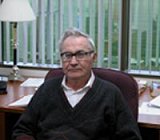Pytor Ufimtsev

Advances in Diffraction Theory
If you look at the shadow cast by an object, you will see, if you look closely enough, variations in brightness in the shadow.
These variations of light and dark cannot be explained by assuming a straight line propagation of light rays.
This phenomenon of "diffractio", or diffraction of light, as we now call it, was first mentioned by Francesco Grimaldi in the 17th century.

The basic equations that describe diffraction, while easy to write down,
are notoriously difficult to , and exact closed form solutions are rare.
In the late 1950s, the Russian scientist Ufimtsev developed and expanded the earlier work
of H.M. MacDonald (cf.
Electric Waves
and also
here
where MacDonald's Physical Optics was first introduced), and developed a powerful
asymptotic
method for solving high-frequency diffraction problems.
This new method was particularly suited to stealth design,
since it enabled the far field diffraction pattern of radar waves from airplanes to be calculated.
In particular, it was now possible to calculate what shapes would NOT reflect the radar waves back to their source, and hence would be undetectable by radar.
Surprisingly, Ufimstev's work was all but ignored in the Soviet Union,
but not so in the US. After the US Air Force had translated his work from the original Russian,
it was read by Denys Overholser, a radar specialist who realized its practical implications...and in fact, in a matter
of months after he had read the paper, he had translated it into a computer program, ready for stealth design at the
fabled "Skunk Works" shop. Both the Lockheed F-117 Stealth Fighter and the Northrop B-2 Stealth Bomber were designed with the aid of Ufimtsev's approach.
 Cogitations on Physics, Math, and Computers
Cogitations on Physics, Math, and Computers